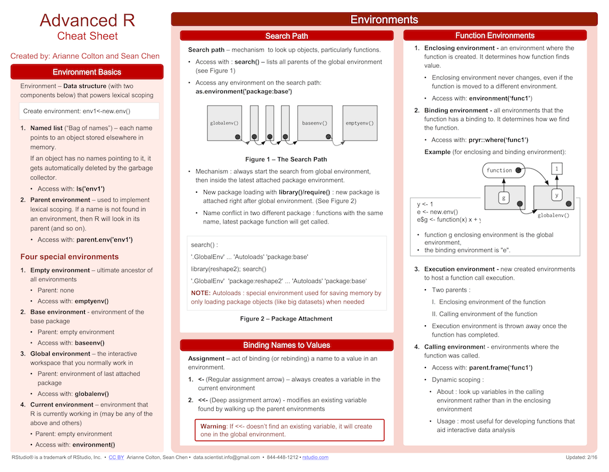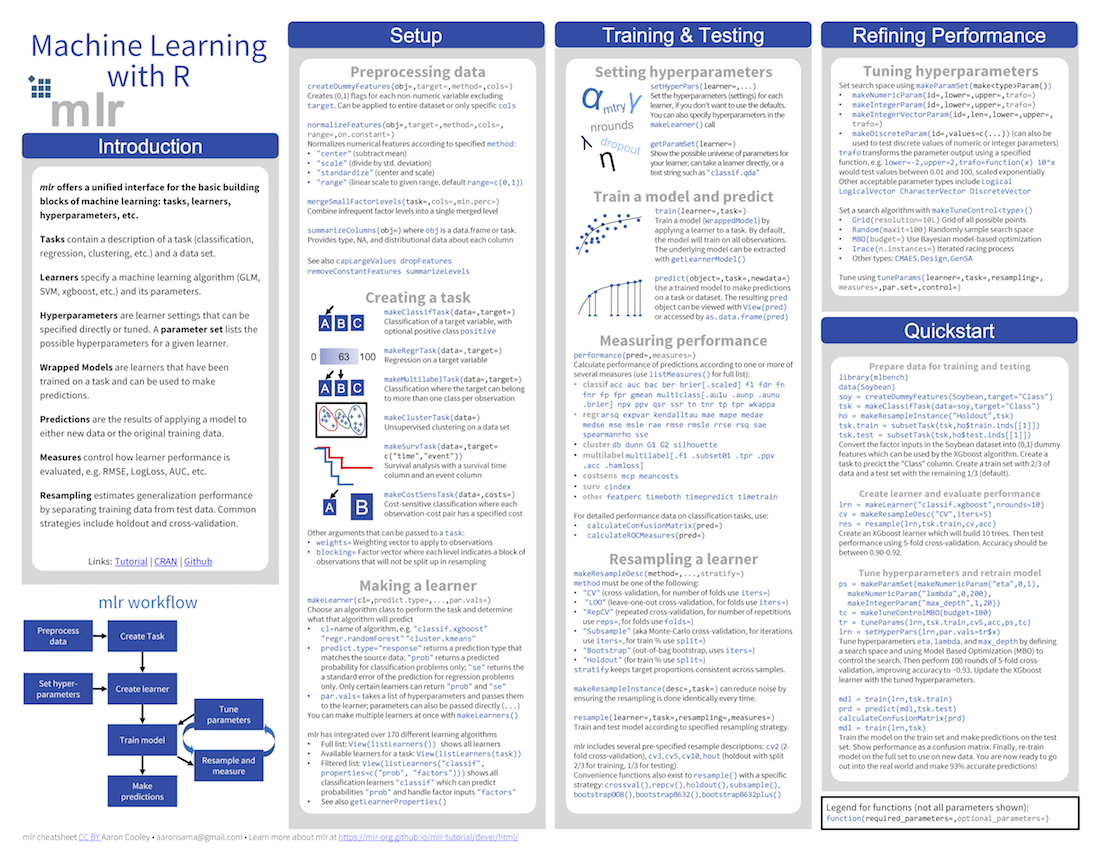In a previous post, I described how I was captivated by the virtual landscape imagined by the RStudio education team while looking for resources on the RStudio website. In this post, I’ll take a look atCheatsheets another amazing resource hiding in plain sight.
Apparently, some time ago when I wasn’t paying much attention, cheat sheets evolved from the home made study notes of students with highly refined visual cognitive skills, but a relatively poor grasp of algebra or history or whatever to an essential software learning tool. I don’t know how this happened in general, but master cheat sheet artist Garrett Grolemund has passed along some of the lore of the cheat sheet at RStudio. Garrett writes:
One day I put two and two together and realized that our Winston Chang, who I had known for a couple of years, was the same “W Chang” that made the LaTex cheatsheet that I’d used throughout grad school. It inspired me to do something similarly useful, so I tried my hand at making a cheatsheet for Winston and Joe’s Shiny package. The Shiny cheatsheet ended up being the first of many. A funny thing about the first cheatsheet is that I was working next to Hadley at a co-working space when I made it. In the time it took me to put together the cheatsheet, he wrote the entire first version of the tidyr package from scratch.
It is now hard to imagine getting by without cheat sheets. It seems as if they are becoming expected adjunct to the documentation. But, as Garret explains in the README for the cheat sheets GitHub repository, they are not documentation!
In addition to data frames/tibbles, dplyr makes working with other computational backends accessible and efficient. Below is a list of alternative backends: dtplyr: for large, in-memory datasets. Translates your dplyr code to high performance data.table code. Dbplyr: for data stored in a relational database. Translates your dplyr code to SQL. The easiest way to hook up to an external database from within your Shiny app is to use dplyr. The dplyr package is a very popular data manipulation package that aims to provide a function for each basic verb of data manipulation: filter (and slice) arrange select (and rename) distinct mutate (and transmute. Python in the IDE Requires reticulate plus RStudio v1.2 or higher. Matplotlib plots display in plots pane. Execute Python code line by line with Cmd + Enter (Ctrl + Enter) Source Python scripts. Syntax highlighting for Python scripts and chunks Press F1 over a Python symbol to display the help topic for that symbol. Tab completion for Python.
RStudio cheat sheets are not meant to be text or documentation! They are scannable visual aids that use layout and visual mnemonics to help people zoom to the functions they need. … Cheat sheets fall squarely on the human-facing side of software design.
R Studio Cheat Sheet Ggplot
R with dplyr and tidyr cheat sheet. Whenever I used R for my data analyses, I had to write a lot of codes to manipulate my data, and sometimes the codes cannot be maintainable. Thanks to dplyr and tidyr packages I no logner need to write long and redundant codes. J f m a m j a s o n j d x j f m a m j a s o n j d x 2018-01-31 11:-01-31 11:-01-31 11:-01-31 11:-01-31 11:-01-31 11.
Cheat sheets live in the space where human factors engineering gets a boost from artistic design. If R packages were airplanes then pilots would want cheat sheets to help them master the controls.

The RStudio site contains sixteen RStudio produced cheat sheets and nearly forty contributed efforts, some of which are displayed in the graphic above. The Data Transformation cheat sheet is a classic example of a straightforward mnemonic tool.It is likely that even someone who just beginning to work with dplyr will immediately grok that it organizes functions that manipulate tidy data. The cognitive load then is to remember how functions are grouped by task. The cheat sheet offers a canonical set of classes: “manipulate cases”, “manipulate variables” etc. to facilitate the process. Users that work with dplyr on a regular basis will probably just need to glance at the cheat sheet after a relatively short time.
The Shiny cheat sheet is little more ambitious. It works on multiple levels and goes beyond categories to also suggest process and workflow.
The Apply functions cheat sheet takes on an even more difficult task. For most of us, internally visualizing multi-level data structures is difficult enough, imaging how data elements flow under transformations is a serious cognitive load. I for one, really appreciate the help.

Cheat sheets are immensely popular. And even in this ebook age where nearly everything you can look at is online, and conference attending digital natives travel light, the cheat sheets as artifacts retain considerable appeal. Not only are they useful tools and geek art (Take a look at cartography) for decorating a workplace, my guess is that they are perceived as runes of power enabling the cognoscenti to grasp essential knowledge and project it in the world.

R Cheat Sheets
When in-person conferences resume again, I fully expect the heavy paper copies to disappear soon after we put them out at the RStudio booth.
